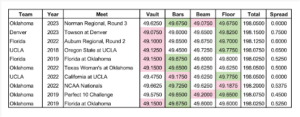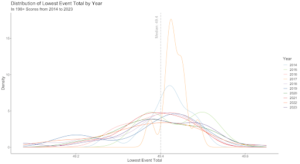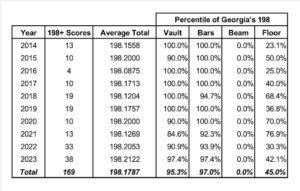Collegiate gymnastics has come a long way since the first NCAA season in 1982. Over the past four decades, national championship-winning scores have risen from 148.6 in the inaugural season to 198.3875 in 2023. Before 1993, scores had been increasing slowly, with the 1992 Utah Utes winning it all with a score of 195.65. But in 1993 Georgia took it to a whole new level, winning the NCAA title with a score of 198 and setting an NCAA record. Between 1993 and 2013, the Bulldogs’ score was only surpassed twice at the national championships.
In the years since 2013, higher total scores have become more common. The last six NCAA titles were won with scores of 198 or higher, and this past year was no different as Oklahoma took the title with a score of 198.3875. Between Georgia’s 198 in 1993 and Oklahoma’s this past April, collegiate gymnastics has changed in many ways, from rule changes to competition formats and even which teams are the most dominant.
At the time, Georgia was one of the premier teams in the country. The Bulldogs were known for their elite difficulty and were seldom rivaled by any other school in the nation.
K.J. Kindler, then an assistant coach at Iowa State, saw this elite difficulty firsthand. “They were willing to take risks that other teams weren’t willing to take,” said Kindler. “They certainly had the recruits and the talent to do it, so they had great difficulty. … Georgia always stood out as competing the most difficult skills in the country.”
Kindler, now the head coach of the reigning NCAA champion Oklahoma Sooners, has taken her team to the top with a different focus: consistency in execution.
Throughout Kindler’s time as head coach at Iowa State and now Oklahoma, consistency from top to bottom in the lineup has been her way of pushing her team forward. The strategy seems to be working; the Sooners have picked up six NCAA national championships along the way.
“For me, consistency wins,” Kindler said. “Certainly injuries are a part of our sport, and to be prepared, knowing that that can happen, and to have a squad that understands that and prepares equally, whether they’re number 12 in the lineup or number one in the lineup, that mentality creates consistency which creates success. … It’s a detail-oriented game, and you have to be willing to focus in on those details.”
Despite the differences between the two teams and a 30-year time jump, both reached the pinnacle of achievement in collegiate gymnastics when they won NCAA titles.
So just how dominant were the 1993 Bulldogs? Georgia put up scores of 49.725 on vault, 49.750 on bars, 48.925 on beam, and 49.600 on floor to clinch their 198.000. Comparatively, when the Sooners won last season’s title, their scores were 49.5625 on vault, 49.6375 on bars, 49.5125 on beam and 49.6750 on floor, bringing them to 198.3875.
Both the Sooners and the Bulldogs took first on floor in their respective championship years, while Georgia also won vault and bars. Its 49.750 team bars score is still ranked among the top team bars scores in NCAA history, tied for fourth with scores from LSU in 2018 and UCLA in 2001.
While Georgia may have scored better than Oklahoma on vault and bars, it wouldn’t have been able to reach 198 without posting such high scores, especially for the time. For all their excellence on the other events, the Bulldogs struggled comparatively on beam, just falling short of a team score of 49. To put the changes in scoring into perspective, in 1993, that score was enough to earn Georgia second place on the event.
Granted, a sub-49 score may have been less rare back then. Only one team in that Super Six went 49-plus on beam, while at least one team went sub-49 on each event. For modern gymnastics fans, it may be hard to conceive of a team putting up a low event total–particularly one as low as a sub-49 score–and still reaching the 198 mark. So, just how rare is it for a team to notch a low score on an event but still go 198-plus?
Below is a table of 198-plus scores from the last decade that also include the 10 lowest-scoring team event totals. The lowest-scoring event is in red, the highest-scoring event is in green, and the spread is the green score minus the red score. No team has gone sub-49 and still posted 198-plus in the last decade.

Going back further, scores were compiled to create a chart showing the distribution of lowest-scoring team event totals by year for 198-plus scores in the last decade. The median of 49.4 across all 10 years is still substantially higher than Georgia’s 48.925 on beam.

This then presented the question, how rare is it for a 198-plus score to include a large spread between the highest-scoring and lowest-scoring team event totals? Below is a table of the 10 largest spreads. The largest was 0.750, which was close to, but still less than, Georgia’s 0.825 1993 spread of 49.750 to 48.925.

An important part of this story is that the scores put up by Georgia on the other events that helped boost them to 198 weren’t only notable for their time. Putting Georgia’s 198 within the context of percentiles of event totals for teams who went 198-plus over the past 10 years shows that even now–with judging and scoring rule changes aside, such as the FTY devaluation on vault–Georgia’s vault and bars team totals still hold up against more recent team totals. (Percentiles were calculated as percent of team event totals less than Georgia’s, e.g., 100% of team vault totals in the 198-plus scores from 2014 were less than Georgia’s 49.725).

In order to dominate the way it did as a team, Georgia’s gymnasts also had to dominate individually. Between Lori Strong, Heather Stepp, Hope Spivey-Sheeley, and Agina Simpkins, the Bulldogs posted five perfect 10s to reach 198, doing something that no other 198-plus scoring team in the past decade has done.
The closest was Michigan with four in 2022, including three on vault, which was more than Georgia’s number of 10s on any given event when it hit 198.

Since Georgia broke the 198 barrier for the first time in 1993, collegiate gymnastics has continued to evolve. Last season alone, the Sooners posted scores of 198 or higher at 10 different meets, including four of their five postseason performances.
In 2004, Stanford posted the highest-ever team score of 198.875. Two days later, UCLA matched it. Since then, no other team has breached 198.8. Even so, as teams continue to improve and move closer and closer to reaching that mark, the possibility of a score in the 199s becomes more and more plausible.
“We are still teetering in the mid-198s when someone has the absolute meet of their life, which can happen any weekend at a time,” Kindler said. “Do I think that that could creep up? Sure. At any given time, you can have the meet of your life.… I just think it would be magical (to see a 199). … I don’t think a 199 is something we would see often, if ever. It’s never been done, so I think it’s incredibly difficult to do.”
As for the next major milestone to be reached in college gymnastics, there are plenty of options aside from a 199-team total. Although it has already been done once, no one since 1996 has scored a 40 in the all around; though a few athletes have come close. Several all-arounders in the last five years have scored a 39.9 or higher. Last season, Trinity Thomas and Jade Carey achieved gym slams throughout the course of the season. Could one of the remaining collegiate all-around powerhouses like 2023 champion Maile O’Keefe or Haleigh Bryant have a good enough performance to do it all in one day? The potential is certainly there.
The highest team event score ever on any event is a 49.925: a score reached by Georgia on vault in 1996 and later Stanford on floor in 2004. Those scores are just three-quarters of a point shy of reaching a perfect 50, another record that doesn’t seem too far out of reach.
Either way, the high-scoring affairs and the dispersal of talent have led to an incredibly competitive sport. On any given day, at any given meet, any team is liable to excel and post a record-breaking score, and in any given season, any team can make an “improbable” title run. That’s just the nature of the sport.
“You have definitely seen, I think, the consistency of our products getting better and better every year,” Kindler said. “Anyone can win on any given day. Even looking at the preseason rankings, you can see, that on any given day, Oklahoma knows that they’re going to be tested. We know that it can go either way, and we just do our best to prepare ourselves. So it is incredibly competitive. … I do think that a lot has changed.”
READ THIS NEXT: Data Deep Dive: Comparing Team Distance Traveled
Article by Tia Reid and Dara Tan




